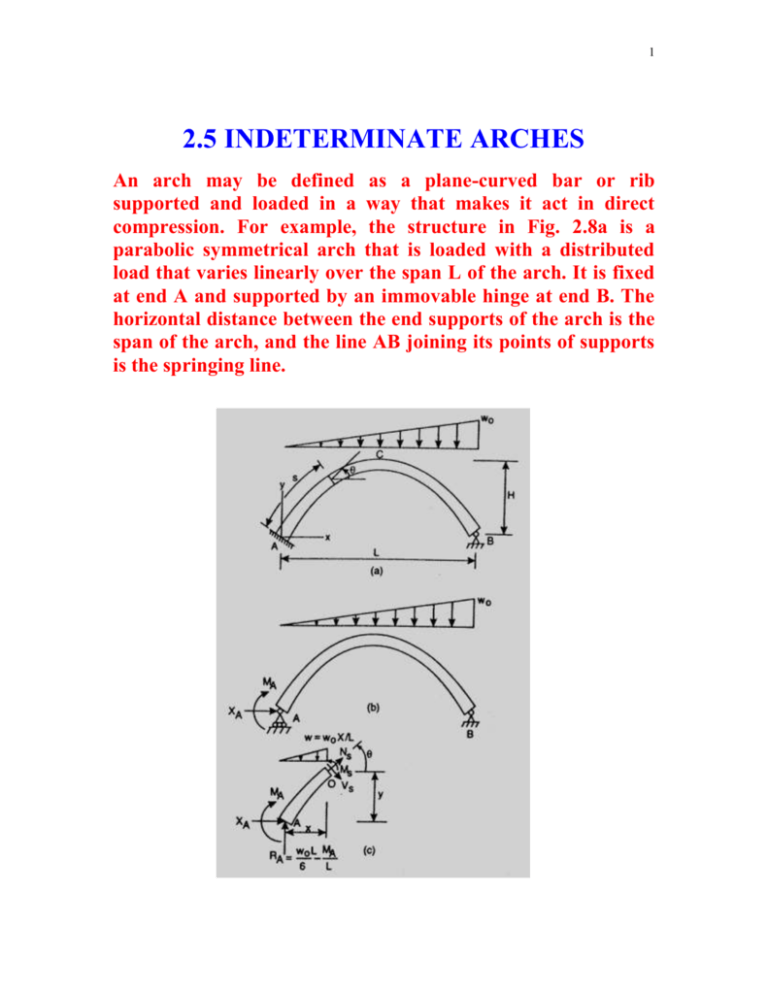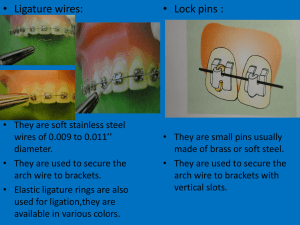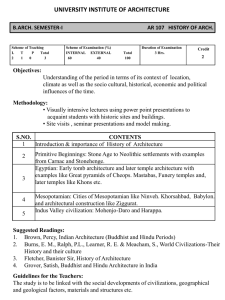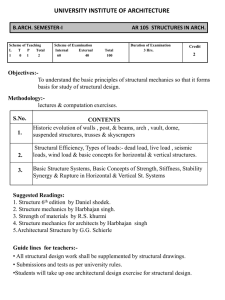Class Notes 2
advertisement

1 2.5 INDETERMINATE ARCHES An arch may be defined as a plane-curved bar or rib supported and loaded in a way that makes it act in direct compression. For example, the structure in Fig. 2.8a is a parabolic symmetrical arch that is loaded with a distributed load that varies linearly over the span L of the arch. It is fixed at end A and supported by an immovable hinge at end B. The horizontal distance between the end supports of the arch is the span of the arch, and the line AB joining its points of supports is the springing line. 1 Fig. 2.8 (a) Parabolic arch of variable thickness loaded as shown. (b) Parabolic arch loaded with redundant force XA, redundant moment MA, and applied distributed loading. (c) Free-body diagram of a segment of the arch. For the arch in Fig. 2.8a, the span and springing lines of the arch are the same because points A and B are at the same level with respect to the y axis. The highest point C of the arch is the crown, and an arch may be a symmetrical arch or an unsymmetrical arch. If, for example, one end of the arch is lower than the other, then the arch is unsymmetrical. Various types of arches are shown in Figs. 2.9 and 2.10. Fig. 2.9 Circular arches: (a) Fixed at one end and hinged at the other. (b) Fixed at both ends. (c) Three-hinge arch. (d) Twohinge arch with supports at different elevation. (e) Two-hinge arch. 1 It is assumed here that the plane of curvature of the arch rib is also a plane of symmetry for each cross section of the arch, and the externally applied loads are assumed to act only in this plane. On this basis, we have a two-dimensional problem and the deformation of the arch will take place in the plane of symmetry. The maximum vertical distance from the springing line to the arch axis, denoted as H in Fig. 2.8a, is the rise of the arch. 2.4.1 Parabolic Arch of Variable Thickness We consider the linearly elastic variable-thickness parabolic arch in Fig. 2.8a that is loaded by a distributed load of maximum intensity w0 and varying linearly over the span of the arch. At any arc length s from support A, the moment of inertia Is is assumed to vary as follows: I dx ds I s (2.108) I s I c sec , cos c sec Is ds dx Ic where Ic is the moment of inertia at the crown C of the arch, and dy tan 1 (2.109) dx 1 Fig. 2.10 (a) Two-hinge parabolic arch. (b) Two-hinge elliptical arch. (c) Two-hinge hollow arch. (d) Two-hinge with horizontal tie. (e) Twin circular arch Since the parabolic arch in Fig. 2.8a is statically indeterminate to the second degree, the horizontal force XA and bending moment MA at support A are taken as the redundants. On this basis, the arch is reduced to one that is hinged at end B, supported by roller at end A, and loaded as shown in Fig. 2.8b. By considering a segment A0 of the arch as shown in Fig. 2.8c, the normal force Ns, shear force Vs, and bending moment Ms at the end 0 of the segment may be determined by using the three static equilibrium equations. For example, by taking moments about the end 0 of the segment and assuming counterclockwise moments as positive, we have w0 x 3 w0 L M A M x M X y M 0 0 6 L A A s 6L (2.110) Note that in Fig. 2.8c is the vertical reaction at end A in Fig. 2.8b, and it may be determined from this figure by using statics. By solving Eq. (2.110), we find w Lx x M s M A 1 X A y 0 (1 x 2 ) (2.111) L 6 1 By setting equal to zero the sum of the forces in the vertical direction, Fig. 2.8c, and assuming upward forces as positive, we have w0 L w0 x 2 M A Fy 6 2L L Vs cos N s sin 0 (2.112) By setting equal to zero the sum of the forces in the horizontal direction of the segment, we find (8.113) Fx X A Vs sin N s cos 0 The simultaneous solution of Eqs. (2.112) and (2.113) for Vs and Ns yields w L w x2 M N s X A cos 0 0 A sin 2L L 6 w L w x2 M Vs X A sin 0 0 A cos 2L L 6 (2.114) (2.115) From Example 1.3 of Section 1.5, an equation analogous to Eq. (10) may be written for the complementary strain energy U of the parabolic arch. This equation is U s 0 2 2 s M s KV N s2 s s ds ds ds 0 2 EI 0 2GA 2 AE s (2.116) where S is the arc length of the parabolic arch, A is its crosssectional area at any coordinate s, E is the modulus of elasticity, G is the shear modulus, and K is the shear factor. The shear factor K may be determined as shown in Example 1.3. For rectangular cross sections K is 1.2. When the rise of the arch is large compared to its thickness, say a ratio of 10 or larger, then the complementary strain energy due to Ns and Vs would be small compared to the one produced by Ms and it can be neglected. On this basis, Eq. (8.116) yields U s 0 M s2 ds 2 EI s (2.117) The integrations in Eq. (2.116), or Eq. (2.117), may be simplified by using the expression I (2.118) ds s dx Ic 1 Thus, by substituting Eqs. (2.111) and (2.118) into Eq. (2.117), we find U L 0 1 2 EI c 2 w0 Lx x 2 M A 1 L X A y 6 (1 x ) dx (2.119) 2.4.2 Additional Subjects and Methods The values of the redundant force XA and redundant moment MA may be obtained from the minimizing conditions U 0 X A U 0 M A (2.120) (2.121) Application of Eqs. (2.120) and (2.121) yields w Lx x M A 1 X A y 0 (1 x 2 ) ( y )dx 0 0 6 L L w0 Lx 1 x x 2 0 2EI c M A 1 L X A y 6 (1 x )(1 L )dx 0 L 1 2 EI c (2.122) (2.123) By considering the geometry of the arch in Fig. 2.8a, we find y 4 Hx ( L x) L2 (2.124) By substituting Eq. (2.124) into Eqs. (2.122) and (2.123) and performing the required integrations, we obtain the following two equations, which are in terms of the redundants XA and MA: 16 HX A 10 M A w0 L2 0 120 HX A 120M A 7 w0 L2 0 (2.125) (2.126) Simultaneous solution of Eqs. (2.125) and (2.126) yields 1 5w0 L2 72 H w0 L2 MA 90 XA (2.127) (2.128) With known XA and MA, the values of Ms, Ns, and Vs may be determined from Eqs. (2.111), (2.114), and (2.115), respectively. They are as follows: x 5w0 L2 y w0 Lx 1 (1 x 2 ) 72 H 6 L 2 2 w L w x 5w L w L2 N s 0 cos 0 0 0 sin 72 H 2L 90 L 6 Ms w0 L2 90 w0 L w0 x 2 w0 L2 5w0 L2 Vs sin cos 72 H 2L 90 L 6 (2.129) (2.130) (2.131) 2.4.3 Semicircular Arch with Hinged Ends We consider now the uniform semicircular arch in Fig. 2.11a that is hinged at the support points A and B and loaded by a uniformly distributed load w as shown. The moment of inertia I is uniform throughout the arch. Since the arch is statically indeterminate to the first degree, the horizontal reaction XA at the end A is taken as the redundant. On this basis, we have an arch that is hinged at end B, supported by roller at end A, and loaded by the reactive force XA and applied load w as shown in Fig. 2.11b. By considering the free-body diagram of the arch segment AC in Fig. 2.11c and applying the three static equilibrium equations, the expressions for the normal force 1 Fig. 2.11 (a) Semicircular arch hinged at the end supports. (b) Semicircular arch loaded with redundant force XA and applied distributed load w. (c) Free-body diagram of a segment of the arch. 2.4.4 Additional Subjects and Methods 1 Ns, shear force Vs, and bending moment Ms, may be determined. For example, by setting equal to the sum of the moments about point C of the segment, we find M s wr 2 (1 cos ) X A r sin wr 2 (1 cos ) 2 2 (2.132) The static equilibrium equations in the horizontal and vertical directions of the arch segment yield wr wr (1 cos ) Vs sin N s cos 0 (2.133) (2.134) X A Vs cos N s sin 0 Simultaneous solution of Eqs. (2.133) and (2.134) yields N s X A sin wr cos 2 (2.135) (2.136) Vs wr cos sin X A cos By considering only the complementary strain energy due to bending and using Eq. (2.132), we find /2 U 2 0 1 EI M s2 d 2 EI /2 0 2 wr 2 2 wr (1 cos ) X A r sin 2 (1 cos ) d The redundant reaction XA may be determined by using the equation U 0 X A (2.137) Equation (2.137) yields 2 EI /2 0 2 wr 2 wr ( 1 cos ) X r sin (1 cos ) 2 (r sin )d 0 A 2 (2.138) 1 By integrating Eq. (2.138) and solving for XA, we find XA=0.4099wr (2.138a) By substituting Eq. (2.138a) into Eqs. (2.132), (2.135), and (8.136), we find wr 2 M s wr (1 cos ) (1 cos ) 2 0.4099wr 2 sin 2 N s 0.4099 wr sin wr cos 2 2 Vs wr cos sin 0.4099wr cos (2.139) (2.140) (2.141)







